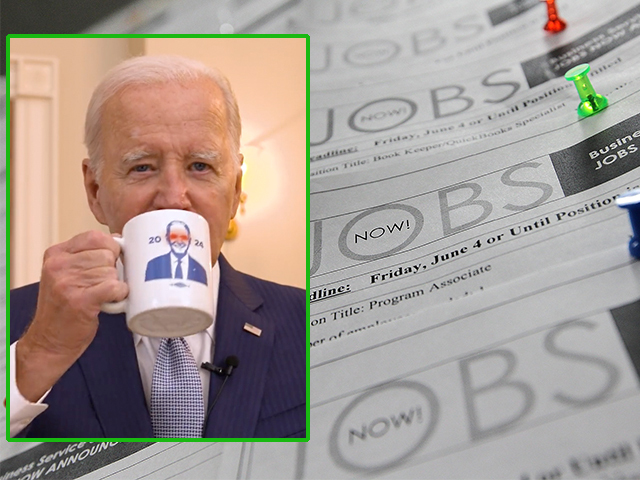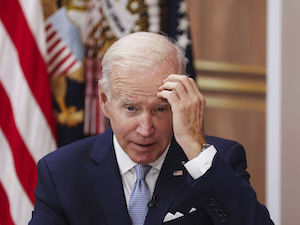The conventional wisdom about Friday’s disappointing jobs data was that there was a little something for everyone. And, for once… the conventional wisdom is right…

They are called ‘Blow‘ – Jobs Joey!
The headline jobs number fell below Wall Street’s expectations, suggesting a softening of the labor market. The average workweek slipped as well, which is often the first sign of an employment downturn. Employers tend to reduce hours of their workforce before they start actually sending out the pink slips.
On the surface, this is bad news for the Biden campaign, which has hitched its wagon to the far-flung notion that the Biden presidency has been a blessing for the American economy. Weakening job growth makes that a harder sell – as would the spread of labor strife from Hollywood to the UAW.
Below the surface, however, this might be a boon for Biden. A quick glance at any public opinion poll shows that inflation is regarded as the number one problem facing the United States. And for very good reason: we are living in the worst stretch of inflation in generations. A softening labor market could both directly ease inflation pressures and be evidence of an anti-inflationary reduction in the growth of aggregate demand. Anything that brings down inflation is no doubt welcome news to the Biden camp.
That’s especially true if the softening of the labor market does not become something much worse. So far, that’s been the case. The unemployment rate has stayed very low. In fact, it ticked down to 3.5 percent in July from June’s 3.7 percent. It has remained in a range of 3.4 percent to 3.7 percent for 17 months – something it hasn’t done for over 15 years.
The public is not giving Biden much credit for the strength of the jobs market, according to most surveys. That’s quite reasonable because unemployment was also extremely low pre-pandemic, when Donald Trump occupied the White House. Perhaps more importantly, the strength of the labor market has made “jobs” a far less important political issue than it was in the years following the Great Recession, when unemployment was stubbornly high.
To the extent that this is a long-term change in the U.S. economy – and we think it probably is – politicians will have to adjust their policies and rhetoric to move from emphasizing “job creation” and focus on other economic issues such as supply chain security, ample energy, shared prosperity and broader opportunity, and family formation, which also encompasses the perennial issues of housing costs, affordable health care, and student debt.
Inflationary Hazard Lights Flashing
There’s also the matter of wages. The average hourly wage rose 0.4 percent in July compared with a month earlier. Year-over-year, wages are up 4.4 percent. This too cuts at least two ways politically.
On the one hand, it likely means that wage growth beat inflation in July. The consumer price index (CPI), which will be released next week, is likely to be up by less than the wage growth on an annual basis. The Federal Reserve Bank of Cleveland’s inflation Nowcast has year-over-year CPI rising 3.4 percent. Its month-to-month figure matches wage growth at 0.4 percent, and Wall Street’s consensus is that it will be lower than that. Bank of America forecasts 0.2 percent inflation for the month.
The Biden campaign has already been touting the fact that in recent months wages have risen faster than inflation. On a longer timeline, this is not true. Wages are playing catch-up after prices exploded higher last year. But catching up is better than not catching up, and it’s a fine enough talking point for politics.
On the other hand, the Fed is likely to look at this wage growth as a warning sign that the economy may still be overheating. Both the month-to-month and year-over-year figures are too high to be consistent with the Fed’s two percent inflation goal. What’s more, the figures suggest that instead of cooling off, wage growth is accelerating.
This raises two dangers. The first is that inflation itself could accelerate as higher wages feed into more consumer spending power, pushing prices up. With the public extremely concerned about inflation already – and extremely unhappy with the Biden administration’s management of inflation – this could be politically fatal. It could even prompt Sen. Joe Manchin (D-WV) to mount a challenge to Biden in the primaries or even a third-party run on the platform of anti-inflationary fiscal austerity. Certainly, Biden’s Republican rival will run hard against rising inflation.
The second danger is that accelerating wage pressure is likely to be seen by the Fed as a reason for precautionary rate hikes. Since the market has pretty much priced in the idea that we’re at peak rates, this could be calamitous for stocks and risk assets. Further hikes might also snuff out the nascent housing recovery and reignite the manufacturing downturn. There’s a significant chance that the Fed might raise rates enough to push the economy into a recession – in fact, it might have to do so to get inflation under control. An election-year recession would obviously be very bad for Biden.
RELATED: Biden’s Economic Approval a ‘Head-Scratcher’ — But Inflation Is ‘Still Way Up’ from Two Years Ago

WTF???
Recession Is Still a Risk
We spent the first half of this year out of consensus by being bullish on the economy, pushing back against the idea that the economy was likely to fall into a recession instantly. Now the consensus has stampeded in the other direction, all but ruling out a recession due to the blessing of immaculate disinflation and the soft-landing. We’re still out of the consensus here. A recession still looks likely next year, although maybe not until later in the year.
The last time unemployment ran this low for this long was November 2007…
One month later, the recession began.
Written for and published by Breitbart Business Digest ~ August 4, 2023








